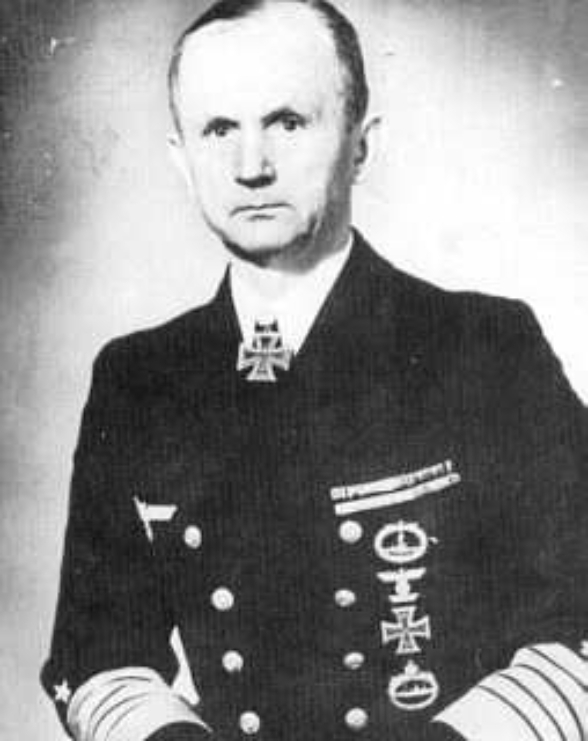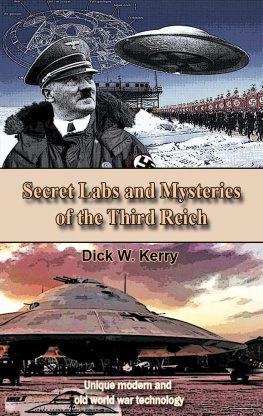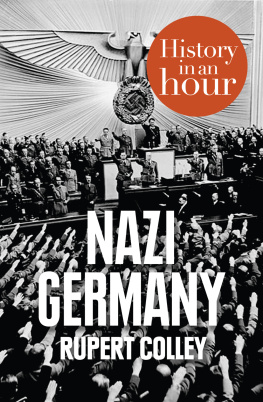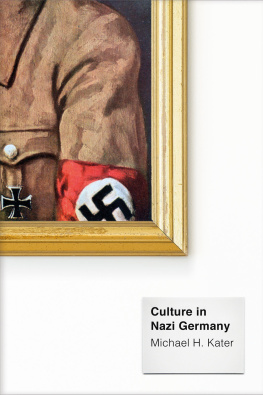Untold Secrets of Nazi Germany
Unique modern and old world war technology
Dick W. Kerry
All rights reserved
Dick W. Kerry, 2017
PBS Astreul, Kiev, Ukraine, 2018
None of the parts of this book cannot be copied without the consent of the author or the right holders
Design by Fred Burgess
Fotos by:
Jim Thorston
Daniel Smith
Gina Smith
Tanya Dolski
Sam Sanderson
Chris Parkinson
The book Untold Secrets of Nazi Germany is devoted to secrets and ambiguous facts in the history of Germany and, especially, to people who are associated with them.
This collection is compiled from previous books, and also includes new articles on missiles and jet engines.
In the history of Nazi Germany there are many unsolved mysteries. Those who are fond of the history of World War II are interested in such secrets of the Third Reich as the construction of dungeons and secret bases, the development of the submarine fleet and submarines and also the fate of gold and museum valuables of Hitler's Germany.
This book is a collection of essays and articles that will be able to provide answers to some of these mysteries.
Content:
Unfortunately, English is not the author's native language. All errors and inaccuracies in the book remain on his conscience.
Nazi underground plant in Austria
Landslides are not uncommon in Austria, in its mountainous regions. In some cases, they are so powerful that as a result, houses are destroyed, large areas of the forest die. Frequent rains in the foothills are the main, but not the only reasons. Loss of soil also occurs in places where underground there is a giant network of underground tunnels and bunkers - the former military factories of the Third Reich, stretching for tens of kilometers.
Austrian find
These secret underground factories are one of the most ambitious projects of the Nazis. Work on the creation of a new "miracle weapon", which was supposed to turn the tide of a long-lost war and bring victory to the "Third Reich", did not stop there until the very surrender of Nazi Germany.
According to experts, the largest object of this kind on the territory of Austria was an underground complex code-named "Bergkristall" ("Mountain Crystal"). The total area of its mines and adits is supposedly almost 300 thousand square meters. Late last year, the entrance to this underground labyrinth was discovered by the film crew of the Austrian documentary filmmaker Andreas Sulzer in the vicinity of the town of St. Georg an der Gusen, about 20 kilometers from Linz.
The filmmakers worked there on a project about the V-1 and V-2 missile program. The film was shot at the request of the German TV company ZDF. Its creators tried to reconstruct the details of the biography of SS Obergruppenfuehrer General Hans Kammler, responsible for the Third Reich's missile program.
Prisoners at construction
Some experts believe that it was in these underground laboratories that work was carried out to create the atomic bomb. There are grounds for such assumptions: the level of radiation here and today exceeds the norm.
According to other historians, the network of labyrinths found by Austrian filmmakers was occupied, first of all, by the Nazi underground factory B 8 Bergkristall, which, in particular, produced the world's first Messerschmitt ME262 turbojet military aircraft.
According to documents found in the course of archival research, a military facility near St. Georg an der Gusen was built in 1944. It was built by forced laborers from Eastern Europe and prisoners of the nearby Mauthausen concentration camp.
According to the Austrian historian Johannes Sachslehner, whose findings are cited by the weekly Spiegel, out of 60-70 thousand prisoners involved in the facility in St. Georg an der Gusen, about 10 thousand died - due to the harsh working conditions and abuse. In total, the number of those who died during the construction of Nazi underground factories amounted to about 320 thousand people, scientists believe.
No documentation
By order of the Austrian authorities, after the Second World War, most of the Nazi underground tunnels (at least, the entrances to them) were filled with concrete or clogged with earth. But a number of labyrinths were simply freed from equipment, the dismantling of which was carried out by representatives of the victorious powers, and some of them were rented out. Austrian farmers used the undergrounds, for example, to store agricultural machinery and grow mushrooms.
But over time, water began to seep through the arches of the underground halls, they became damp and began to collapse, and repairs required a lot of money. The land on which the network of former Nazi secret sites in Austria is located is managed by the Austrian Federal Real Estate Company (Bundesimmobiliengesellschaft, BIG). In total, we are talking about about 150 tunnels. It is not clear what to do with them. Even just using these land plots for residential or office development is dangerous: the risk of landslides is too great.
The 10-kilometer tunnel, where the most secret weapon of the Third Reich was supposedly developed, is almost completely walled up. Only two kilometers of the labyrinth remained intact. BIG prohibits excavation in it due to increased radiation. And there is no documentation related to the object. According to Andreas Sulzer, based on the information obtained in the archives, it was taken out in 1955 by the command of the Soviet troops stationed here at that time. There is no access to it now.
Karl Dnitz. Father of the German Kriegsmarine
Karl Dnitz was born on September 16, 1891 in Grnau near Berlin and was the second and last child of the optician engineer Emil Dnitz, who worked in the famous firm of Karl Zeiss in Jena. The children were left without mother early. Emil Dnitz understood that only a good education would provide his sons with a decent future. Karl studied first at the Zerbst gymnasium, and then at a real school in Jena. On April 1, 1910, young Dnitz began training at the naval school in Kiel.
While still a cadet, Dnitz was an industrious and withdrawn young man who considered "devotion to duty as the main moral value." During his studies he was not particularly distinguished and did not enjoy the respect of his comrades. In 1912 he was transferred to the naval school in Murvik, and then, to complete the training, he was appointed watch officer for the light cruiser Breslau. In the autumn of 1913, Dnitz was promoted to the lieutenants of the zur zeye. During the Balkan crisis, Breslau participated in the international blockade of Montenegro.
The beginning of the First World War found "Breslau" in the Mediterranean Sea. He managed to escape from the British to Turkey, where the cruiser joined the fleet of the Ottoman Empire and fought in the Black Sea against the Russians. During one of the raids "Breslau" broke into the harbor of Novorossiysk, sank all the ships there and destroyed the oil storage.
In July 1915, at the entrance to the Bosporus Strait, Breslau was blown up by a Russian mine. While the cruiser was repaired, Dnitz settled in the Air Force and took part in the fighting at Gallipoli as an arrow and a manat. In February 1916, he was promoted to the Ober-lieutenants of the zurye, and in the summer he was recalled to Germany and sent to retrain to an officer of the submarine fleet, on whom high hopes were placed.







